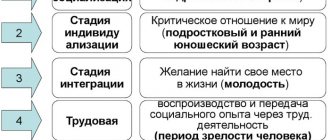Updated January 29, 2022 530 Author: Dmitry Petrov
Hello, dear readers of the KtoNaNovenkogo.ru blog. Motive plays a key role in our lives, but not everyone fully understands what it is.
The fact is that this term has many meanings, as it is used in various spheres of life - fine arts, literature, music, biology and even criminology.
But today we will talk about motive as a concept of psychology. All our actions and inactions are justified by motives, their strength, stability and direction.
Therefore, today we will talk about this in the simplest possible language and with examples.
What is motive
Motive
- this is a process that controls human behavior, contributing to its organization, direction, activity and stability. It is also believed that a motive is a certain generalized image of material or ideal objects that are valuable to an individual.
Achieving these objects is the meaning of his activity for him. To a person, a motive is presented in the form of special experiences that can be both positive (when expecting to achieve these objects) and negative (when realizing the incompleteness of one’s position, the lack of this object). Schopenhauer was the first to use the concept of “motivation” in psychology.
Nowadays, the word “motivation” in psychology is understood in different ways. Some researchers believe that this is a set of processes responsible for motivation and activity; while others believe that it is a purely mental phenomenon, representing a collection of motives.
What is motivation in psychology in essence? This concept is used where they talk about achieving a certain goal and specific ways to achieve this. It is known that the same goal can be achieved in different ways. So, if a person wants to become rich, then he can get a job in a prestigious company, open his own business, write a good book, engage in criminal activity... And vice versa - the same action can be performed for different purposes. In addition, the desire to achieve a specific goal can also be explained by one’s own considerations. Why does a person want to get rich? Someone wants to buy a mansion by the sea, someone wants to get married, someone wants to professionally do what they love (and not something that just generates income). In such cases, they say that a person is guided by certain motives.
Usually, a person organizing some kind of activity and achieving a certain goal is guided by several motives at once, which is why psychologists talk about one or another motivation. The problem of motivation in psychology is one of the most difficult. Often a person himself does not realize exactly what motives he was guided by when he performed some actions. There are hidden motives associated with some memories, fears, etc. Such motives are not reflected in consciousness and act on a subconscious level; a person only feels some kind of vague tension, discomfort, which he strives to overcome with the help of certain actions.
Thus, a goal is what we want to achieve, and a motive is the reason why we want to achieve it. Motivation in psychology is understood as both the set of motives that control an individual’s behavior and the process of this control itself.
General characteristics of activities
General characteristics of activities.
One of the obvious external differences between living matter and nonliving matter, higher forms of development from lower ones, more developed from less developed, is that the former are much more mobile and active than the latter. Life in all its forms and manifestations is associated with movement, and as it develops, motor activity increasingly improves its forms. All forms of life differ from each other in their activity. For example, the simplest living beings are more active than the most complex plants. A person is capable of creating living conditions for himself, improving them and being anywhere in the world, and not a single animal can compare with him in the form and variety of his activity
. In addition to all the forms and types characteristic of animals, it has a special form called activity.
ACTIVITY - (English activity; German Tatig-keit) - active interaction with the surrounding reality, during which a living being acts as a subject purposefully influencing the object and satisfying it. your needs. Due to the extreme complexity and continuous variability of external conditions, already at relatively early stages of phylogenesis, a vital need is created for the emergence of mental forms of control over the practical interaction of a living being with the environment. Of particular importance is the development of orientation-research activity, which consists in examining the environment and forming an image of the situation, on the basis of which the orientation and regulation of the animal’s motor behavior is carried out in accordance with the conditions of the task facing it. 1.
Activity can be defined as a specific type of human activity aimed at cognition and creative transformation of the surrounding world, including oneself and the conditions of one’s existence. In activity, a person creates objects of material and spiritual culture, transforms his abilities, preserves and improves nature, builds society, creates something that would not exist in nature without his activity. The creative nature of human activity is manifested in the fact that thanks to it, he goes beyond the limits of his natural limitations and exceeds his genotypically determined capabilities. Historical progress, which has taken place over several tens of thousands of years, owes its origin precisely to activity, and not only to the improvement of the biological nature of man. More and more people are surrounded by objects of their own creation. All objects were touched to one degree or another by the hands and mind of man; they can be considered the material embodiment of human capabilities. The creation of machines, household items, new technologies and other things, all of these human activities are different from the activities of animals, which do not produce anything similar.
The activity has the following main characteristics
: goal, task, motive, subject, structure and means.
A goal is a conscious image of an anticipated result towards which a person’s action is aimed. 3 The goal can be any object, phenomenon or specific action.
The purpose of an activity is not equivalent to its motive, although sometimes the motive and purpose of an activity may coincide with each other. Different activities that have the same goal (end result) can be stimulated and supported by different motives. On the contrary, a number of activities with different ultimate goals may be based on the same motives. For example, reading a book for a person can act as a means of material satisfaction (to demonstrate knowledge and get a well-paid job for this), social (to show off your knowledge among significant people, to achieve their favor), spiritual (to expand your horizons, to rise to a higher level of moral development ) needs. Such different types of activities as purchasing fashionable, prestigious things, reading literature, taking care of appearance, developing the ability to behave, can ultimately pursue the same goal: to achieve someone’s favor at all costs.
A task is the goal of an activity given under certain conditions and requiring the use of means adequate to these conditions to achieve it. The search, mobilization and application of methods and operations constitute the process of solving a problem.
Depending on the nature of the final goal, practical and theoretical tasks are distinguished. Practical tasks are aimed at directly transforming reality, while theoretical ones are aimed at understanding it. 4
In complex types of activity, most often tasks appear not only as a specific goal that needs to be achieved, but as private goals, without achieving which it is impossible to achieve the main goal. For example, in order for a person to build a house, he first needs to write a construction project, find funds, a place and much more, and only then will he be able to achieve the main goal, to build a house.
The motive of an activity is what prompts it, for the sake of which it is carried out. The motive is usually a specific need that is satisfied in the course and with the help of this activity.
The motives of human activity can be very different; organic, functional, material, social, spiritual. Organic motives are aimed at satisfying the natural needs of the body (in humans, at creating conditions that are most conducive to this). Such motives are associated with growth, self-preservation and development of the organism. This is the production of food, housing, clothing, etc. Functional motives are satisfied through various cultural forms of activity, such as games and sports. Material motives encourage a person to engage in activities aimed at creating household items, various things and tools, directly in the form of products that serve natural needs. Social motives give rise to various types of activities aimed at taking a certain place in society, gaining recognition and respect from those around them. Spiritual motives underlie those activities that are associated with human self-improvement. The type of activity is usually determined by its dominant motive (dominant because all human activity is polymotivated, that is, motivated by several different motives).
The subject of an activity is what it directly deals with. So, for example, the subject of cognitive activity is all kinds of information, the subject of educational activity is knowledge, skills and abilities, the subject of labor activity is the created material product.
Every activity has a certain structure. It usually identifies actions and operations as the main components of activity. An action is a part of an activity that has a completely independent, human-conscious goal. For example, an action included in the structure of cognitive activity can be called receiving a book, reading it; actions included in labor activity can be considered familiarization with the task, searching for the necessary tools and materials, developing a project, technology for manufacturing the item, etc.; Actions associated with creativity are the formulation of a plan and its phased implementation in the product of creative work.
An operation is a method of carrying out an action. As many different ways of performing an action as there are, so many different operations can be distinguished. The nature of the operation depends on the conditions for performing the action, on the skills and abilities a person has, on the available tools and means of carrying out the action. Different people, for example, remember information and write differently. This means that they carry out the action of writing text or memorizing material using various operations. A person’s preferred operations characterize his individual style of activity.
The means of carrying out activities for a person are those tools that he uses when performing certain actions and operations. The development of means of activity leads to its improvement, as a result of which the activity becomes more productive and of higher quality.
A person in modern society is engaged in a variety of activities. To create a unified classification of activities will require a lot of effort and time, since in order to describe all types of human activity, it is necessary to list all the most important needs for a person, and their number is very large, which is due to the individual characteristics of people.
But it is still possible to identify the main types of activities that are characteristic of all people. They will correspond to the general needs that can be found in almost all people without exception, or more precisely, to those types of social human activity in which each person inevitably becomes involved in the process of his individual development. These types of activities are: communication, play, learning and work.
COMMUNICATION
- interaction of 2 or more people, consisting in the exchange of information between them of a cognitive or affective-evaluative nature.
Typically, communication is included in the practical interaction of people (joint work, learning
, group
play
, etc.), ensuring planning, implementation and control of their activities.
At the same time, communication satisfies a person’s special need
for contact with other people. The process of communication can be isolated from other forms of activity and acquire relative independence. 7. In each age period, communication has its own specific characteristics, determined by the development of the need-motivational sphere.
The subjects of communication can be both individual people and social groups, layers, communities and even all of humanity as a whole. There are several types of communication:
1. communication between real subjects (for example, between two people);
2. communication with a real subject and an illusory partner (for example, a person with an animal, which he endows with some unusual qualities);
3. communication of a real subject with an imaginary partner (this means communication of a person with his inner voice);
4. communication of imaginary partners (for example, literary characters).
The main forms of communication are dialogue, exchange of opinions in the form of a monologue or remarks.
A game is a product of human activity, through which he transforms reality and changes the world. The essence of human play is the ability to reflect and transform reality. Play is the leading activity of a preschool child. It is in this type of activity that the child’s need to influence the world is formed and manifested and serves as a means of development. For adults, play is not a leading activity, but serves as a means of communication and relaxation. This is the main, central and most general meaning of the game.5
There are several types of games: individual and group, subject and plot, role-playing and games with rules. Individual games are a type of activity when one person is engaged in a game, group games include several individuals; object games are associated with the inclusion of any objects in a person’s gaming activity. Story games unfold according to a certain scenario, reproducing it in basic detail. Role-playing games allow human behavior, limited to a single role that he takes on in the game. Finally, games with rules are regulated by a certain system of rules for the behavior of all participants. There are mixed types of games: subject-role-playing, plot-role-playing, plot-based games with rules, etc.6
Teaching is an activity whose purpose is to acquire knowledge, skills and abilities by a person. Learning can be either organized in special institutions, or unorganized and carried out spontaneously, while carrying out other types of activities. In its focus, the teaching relates to the cognitive activity of people, which always includes the presence of two sides: the cognizing (the subject of cognition is a person) and the cognizable (the object of cognition is objects and phenomena of the surrounding world). Moreover, both of these parties are in close relationship and interaction. A person learns the essence of objective reality not as a passive observer, but always includes it in his activity, reflecting the organization of the learning process itself - the methods and means of cognition, as well as the characteristics of the human psyche - his perception, thinking, positions, preferences, accumulated experience, etc. d. In other words, the cognizing subject is inside the objective world, to which he, as it were, connects through the senses, which are, in the figurative expression of the French writer-thinker D. Diderot, keys that are struck by the surrounding nature.
This is an expedient human activity aimed at modifying and adapting natural objects to satisfy the numerous and varied needs of people. Labor is always aimed at achieving programmed, pre-expected results - its products, which are useful not only for a specific subject of activity, but also for society as a whole. Even in cases where a person does something for himself personally, he uses the experience of other people in his activities, applying the knowledge received from them. In other words, labor activity is social in nature, which is expressed in the joint production of a socially significant product by people. Thanks to labor, all objects of the material and spiritual culture of mankind were created, and modern society was built.
Labor is a historically primary type of human activity, which determines the growth of scientific and technological progress and associated socio-economic transformations. Integration and differentiation of social structures, the complication of production in the course of social development lead to the division of labor and increased specialization of workers, while simultaneously determining their increasing dependence on each other. This, in turn, requires expanding contacts and communication in which activities are planned and their products are exchanged. In the process of interaction between people, the experience accumulated by humanity is transmitted from previous generations to subsequent ones in the form of knowledge, methods of activity, machines and equipment, tools and devices that belong to the category of means of labor. The latter are very diverse and are divided into real and functional. The first include land, minerals, various enterprises, means for carrying out practical actions - manual, machine, automated (machines, machines, tools, etc.), as well as for receiving, transmitting and processing information (computer, telephone, telegraph , books, instructions, etc.). The second includes the human body as a subject of activity (the functions of various organs and systems involved in the implementation of labor processes); groups of people functioning in production who are the object of management (expressive means of their behavior and speech, and others).
Labor activity is primarily associated with the creation and improvement of tools of labor, through which a person’s influence on the object of labor is mediated - a complex system of objects, phenomena, processes and their relationships, which a person must mentally or practically operate in the workplace, turning them into one or another product . In most professions in the mass production of material assets (for example, in assembly line forms of work), objects and products of labor are quite strictly documented. Some types of work activity, including situations of uncertainty, allow for variable and heuristic norms of the subject and product of labor. For example, in the profession of a driver (pilot, navigator, driver, etc.), when the main goal and result of human activity is a timely and safe flight, often carried out in an unforeseen environment (in particular, in constantly changing navigation conditions). In addition, in the subject of work, as well as in its goals, a distinction is made between objective (social) and subjective (personal) components. And this second element of a master of his craft, who introduces elements of creativity into the labor process, may be richer in its characteristics than in prescriptions, samples and instructions, that is, it has a heuristic character
Labor is an activity aimed at transforming material and intangible objects and adapting them to meet human needs. According to the nature of the main efforts expended, labor activity can be divided into several types:
- physical work;
- intellectual work;
- spiritual work.
In theory and in practice, labor, in fact, is understood to the greatest extent as physical labor.
Physical labor can be classified as follows: - self-care work (maintaining home, clothing, workplace in order, preparing food for oneself, etc.);
- domestic family work;
- productive work.
Self-care work is mastered earlier than others in childhood and accompanies a person throughout his life.
Get text
Types of motives in psychology
Psychologists identify a large number of types of motives, dividing them into several categories. It is not easy to create such a classification, since there are a lot of circumstances that guide a person; Each direction of psychology and each school has its own system. However, the most widespread division of motives into four groups.
Internal and external motives
These types are important not only in terms of the choice of means and ways to achieve the goal, but also for the self-realization of human individuality. Internal motives are such as interests, hobbies, the need for positive emotions and avoidance of negative ones, the desire to increase self-esteem, etc. These circumstances are related to the person himself and his attitude to his activities.
External motivation is circumstances that do not depend on a person and his desires and lie outside his personal sphere. These may be motives such as public opinion, a change in weather, the desire to get a higher grade or avoid punishment, etc.
External and internal motivations can work simultaneously, or they can act separately. For example, a student diligently does his homework. He can do this both because he is interested in the topic, and in order to get a good grade, please his parents, brag to his friends, etc.
External motivation plays a fairly large role in human life, since most people need a certain socialization. Such motives are often more effective than internal ones; this is the same “kick in the ass” without which some people will not do anything at all. However, for personal development, internal motives are still the most preferable. Only with their help can you do your work truly productively. All creative activity is based primarily on internal motivation.
Positive and negative motives
Like needs, drives are associated with emotions. A person in his actions can be driven by the desire to receive pleasure, pleasure, and then this is a positive motivation, or he can also be driven by the desire to avoid punishment, pain, fear and other negative experiences, and then this is a negative motivation.
Researchers cannot yet definitively say which of these motives are more effective in achieving a goal. Negative motivation can encourage one to overcome obstacles, endure minor inconveniences, and work until exhaustion; but it also destroys a person who will never truly love or understand his business. Therefore, positive motives still seem more preferable.
Sustainable and unstable motives
Stable motivations are those that are based on human needs and do not require any additional reinforcement. Such motives have existed for quite a long time. Unsustainable motivation changes quickly. Thus, the internal motivations of the individual are stable, since changes in worldview, interests, and tastes occur rarely and gradually. External motivation, on the contrary, is unstable, since the demands of society, the mood of others, and the weather outside change quickly.
Achieving success
This is a separate type of motivation that has become relevant recently. Modern society sets a person up for success from childhood. It is not prestigious to be unsuccessful; success brings with it material well-being, public recognition, and other benefits. Success increases a person's social status.
It would seem that every person wants to achieve success. However, in reality, there are many obstacles on the way to achieving it, which sometimes discourage the desire to achieve success altogether. One of the reasons for this is a person’s lack of understanding of why he needs to achieve this goal. It happens that the set goal is too far away and gets lost among the many obstacles that arise; in this case, it is advisable to break the achievement of this success into several intermediate goals.
Often achieving great success involves leaving the so-called comfort zone. This means sacrificing something small in order to get something much bigger in the end; the ability to take risks, endure small troubles with the expectation that these problems will be more than compensated for when success is achieved. And this is where many potentially successful people give up.
Often the “comfort zone” is presented as a physical, mental, ideological or spiritual space in which a person feels good and comfortable, he does not suffer and, it would seem, is provided with everything he needs. In fact, psychologists understand something different by this concept. For some people, the “comfort zone” is associated precisely with suffering, inconvenience, pain, and leaving this zone can relieve suffering and bring happiness. But a person does not want to make this exit; he feels “good” when he feels bad. What is the reason for this paradox?
This situation is perfectly illustrated in the famous play “Dragon” by E. Schwartz, based on which a film was made in the late 80s. The inhabitants of the fairy-tale city come to terms with the fact that a terrible dragon has established dictatorial rule over them, who sets his own rules and, in particular, regularly demands that the most beautiful girls in the city be given to him. When a brave knight appears and kills the dragon and gives the inhabitants freedom, they immediately... elect a new dictator who makes them suffer in the same way. It turned out that the residents could not make an effort to learn to live without any dictators and suffering: in their minds, freedom, thinking, responsibility and hard work seem to be even greater suffering than the insane rules of this or that dictator, which one can get used to. The dragon freed people from the need to think and gave them, albeit unfair and deceitful, but a simple and understandable picture of the world, which was enough to learn by heart.
How to correctly determine motive and motivation?
Personal psychophysiological stimuli regulate the behavior of an individual and serve as the basis of a person’s mental sphere. Motivation is the driving force that organizes motivating factors and combines them into a coherent system.
A well-built hierarchy makes it easier to achieve goals and increases efficiency. To correctly determine your own motives, dividing them into dominant and secondary ones, deep introspection is required. In psychology, this is considered a fundamental factor in the formation of a harmonious personality.
Types of Human Motivation
Such types of motivation as “carrot” and “stick” are widely known. This is nothing more than an idea of negative and positive motives. These principles have long been used in economics, politics, management, education and other areas, including everyday life.
It is interesting that these types of motivations can characterize not only an individual, but also a certain society. It is known, for example, that since ancient times the Russian consciousness has been more characterized by “stick” motivation than “carrot” motivation. This is even reflected in the proverbs: “Until thunder strikes, a man will not cross himself.” A similar character of the Russian person was noted by researchers of culture and even religion. Thus, one church historian said that Russian Orthodox people have long believed not so much in God as in the devil, and in Russian religious (and for the most part folk-religious) culture, thousands of ways and advice have arisen on how to avoid meeting with evil spirits; at the same time, original Orthodoxy condemns such a practice, because if a person believes in “an all-powerful God,” then he should not be afraid of evil spirits.
“Gingerbread” is largely a Western system of motifs. Thus, in European countries there are a number of incentives for citizens who strictly comply with the law, and a relatively mild system of punishments for those who violate the laws. In our country, the opposite is true: practically nothing is provided for law-abiding citizens, but the system of punishments is extensive, confusing, cruel and clumsy.
However, in modern Western society the role of the “stick” in certain areas is also growing. There, cruel treatment of children and violation of discipline in enterprises are severely condemned. The existing problems, say, in public health care in themselves are a “stick” for Europeans, encouraging them to work hard to pay for private medical services.
Which of these motives are most effective? Each country and each people has its own answer to this question. History shows that European society was favorably influenced by the widespread increase in the “carrot”, that is, the development of positive motives; but opposite trends led to revolutions, strikes, spontaneous and organized mass protests. This has been evident in European history for centuries.
In modern Singapore, the “whip” played a key role in the prosperity of society. There are a great many restrictions and prohibitions in this city-state, and in order to maintain impeccable order, punishments such as caning are widely used. There are no “carrots” for citizens here. And it seems strange to many of us how such methods have led Singapore to an economic and social miracle, high standards of living, social cohesion (and this in a multi-ethnic and multi-cultural country with a high population density) and the absence of mass discontent.
The countries of Eastern Europe, the USA, and China stand out in that their societies maintain a certain balance of incentives. For Eastern Europe, this was especially noticeable during the years of the Soviet bloc: citizens loyal to the state regime, who worked conscientiously and cared about their high “moral character” (from the point of view of the authorities), were guaranteed a fairly high standard of living, a certain degree of civil liberties, provision of consumer goods. And next to this is the brutal persecution of dissidents, dissidents, “parasites,” and the condemnation of an immoral way of life, elevated to ideology. Something similar could be seen in these countries both before and after the “Soviet era.” Only people who were characterized by a struggle between opposing systems of motives could build such a society. To compare this with the Western European system, just look at the prisons in these countries: Norwegian or Dutch ones are more reminiscent of resort hotels, and Polish or Romanian ones are more like a concentration camp.
This makes some sense. In the cultures of different countries, the image of a prison is given the role of a kind of “scarecrow”, with the help of which some people try to motivate others, thereby controlling their behavior. In Russia, the USA, China and the countries of Eastern Europe, a prison is not a correctional institution, but an “institution for the execution of punishments,” and its task is to oppress and destroy the individual, to destroy the criminal morally and often physically. And only the desire not to “slide” to the point of ending up behind bars gives the average person in these countries the impetus to perform socially useful actions (work, provide for their family, respect others, do not steal, do not kill, etc.). The first opportunity to avoid a prison sentence motivates a typical resident of these countries to commit a crime.
The behavior of Europeans is subject to different principles. Apparently, a prison term does not frighten them: after all, the existing restrictions in the prisons there do not humiliate the prisoner as an individual, the prison staff show him a certain respect. But at the same time, the discipline of Europeans, their politeness, and desire to work hard (but not overwork) is amazing. If you leave a wallet with money on a bench in some German city, then, most likely, a week later you will find it there completely untouched (currently the situation is much different due to the abundance of migrants in Germany and other European countries who have completely different psyche). The reason is that the average European is determined to achieve success and maintain his good reputation, and any “wrong” action can ruin this reputation. You won’t go to jail, but your friends will turn away from you, your girlfriend will stop loving you, your parents will kick you out of the house, you won’t be hired by a good organization...
If you delve into history, you can see what motivated people in different countries, creating similar inventions, performing the same actions. A good example is the creation of a printing press. Johannes Gutenberg was definitely positively motivated: with the help of his printing house, he wanted to improve his financial condition, gain fame and influence, become a pioneer of something new, and give people new opportunities for development. He was the creator, chief worker and owner of his enterprise. In fact, he succeeded in his plans: not only merchants and artisans, but also royalty and the church became his clients.
The Russian pioneer printer Ivan Fedorov was motivated by slightly different considerations. For him, his work was rather ritual; he wanted to “serve God.” The visible analogues of “god” for him were rulers, church hierarchs, and boyars. In the first Moscow printing house, opened by the Tsar and Metropolitan for personal needs, Fedorov was a powerless worker, and he did not want to have any personal benefits from this enterprise. For a long time, the pioneer printer was driven by circumstances that did not allow him to fully implement his plans: ordinary priests and book copyists were angry with him, the printing house was quickly burned and forced him to flee the country to Lithuania, and then to Ukraine. Outside Russia, the pioneer printer's business went much better, but again at the expense of strong rulers. The Russian pioneer printer never acquired his own personal printing house. Apparently, the Christian god and government officials were for Fedorov a kind of “whip” that should be feared and served.
“The Man in the Case” is another character, now literary, who was clearly motivated solely by the “whip”. His favorite saying was the expression “no matter what happens,” which he repeated whenever he saw something unusual. Those around him were surprised where this petty official, a quiet and inconspicuous man, suddenly awakened with remarkable energy, with which he began to scribble complaints left and right. All-encompassing fear prompted him to act, while those around him were motivated in their actions by positive considerations.
The struggle of motives
As already mentioned, a person is simultaneously driven by many different motives. And not all of them are equivalent and equally directed. Here's a classic example. A person sets an alarm clock at night, intending to get up early the next morning - for example, to go for a morning run. But the morning comes, the alarm clock rings, and this person no longer wants to get up. He finds himself in a situation where he needs to make a specific decision, and it depends on what motives prevail in him at the moment. Here we come across what is called willpower.
This example is not particularly critical, but there are situations in life when a person has to make very difficult choices. Any of the options for action is motivated in a certain way, and this brings discomfort and even real torment. So, in some cases we are faced with a choice - to save ourselves from trouble or to save our loved ones at the cost of our own lives. Such internal conflicts can lead to the development of depression or neurosis.
What should you do if you need to make such a choice? Experts advise not to give in to emotions and carefully consider all options if possible. There must be a rational approach here; you need to weigh all the pros and cons, the benefits and deprivations that the choice you make will bring. And above all, one should be guided by socially significant motives. After all, it often happens that we achieve our goal by “walking over our heads,” as a result of which friends, close people, and relatives turn away from us, as a result, we lose more than we gain.
A person is not aware of all his motives, but control of his motivational sphere is available to us. It is necessary to create a hierarchy of needs and motivations for yourself and focus on the most significant and important of them. Such a hierarchy will be associated primarily with social values.
The “pyramid of needs” compiled by the American psychologist Abraham Maslow is widely known. This system distributes needs into “lower” ones, which make humans related to other animals, and “higher” ones, which are unique to humans. It is curious that the lower needs are associated with the individual survival of the organism, while the higher ones pursue social goals. The highest needs are the need to understand one’s connection with the entire universe, and not just with one’s small group or human society in general.
Having certain needs, a person acquires the motivations associated with them. And they motivate him to do certain things. It happens that an activity seems “higher”, but in reality a person is guided by “lower” motives. So, a musician can create fashionable but primitive music just to feed himself (and generally make money). It happens that “for bread” people create real masterpieces. In other cases, setting “lower” goals is only an intermediate step, while in reality the person is motivated by higher considerations. Thus, the father of the family can take care of his health in order to have the strength to provide for his wife and children.










